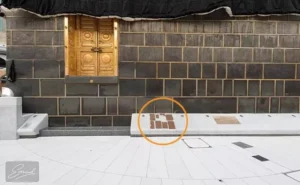Musallah Jibreel, also known as Mujjan, is a significant site located near the Holy Kaaba in Masjid al-Haram, Makkah. It marks the spot where the Angel Jibreel (Gabriel) taught Prophet Muhammad (peace be upon him) the prescribed times and methods of performing the five daily prayers (Salah) following the miraculous night journey (Isra and Mi’raj).
Location and Identification:
Musallah Jibreel is situated at the bottom right-hand side of the Kaaba’s door. Historically, this spot was marked by a square pit, which was leveled in 1985 to facilitate the Tawaf (circumambulation) performed by pilgrims. Currently, it is identified by six brown marble pieces embedded in the white marble slope (Shadharawan) of the Kaaba, indicating the exact location where Angel Jibreel stood.
Historical Significance:
After the event of Mi’raj, where the five daily prayers were ordained, Angel Jibreel demonstrated the precise times and methods of these prayers to the Prophet Muhammad (peace be upon him) at this location. Over two consecutive days, Jibreel led the Prophet in prayer, each day performing all five prayers twice—first at the beginning and then at the end of their respective times. This practice established the permissible time ranges for each prayer.
Narration by Abdullah bin Abbas (رضي الله عنه):
The Messenger of Allah (ﷺ) said:
“Jibraeel (عليه السلام) led me in prayer at the House (Ka’bah). On the first day, he prayed:
- Dhuhr (Noon Prayer): Just after the sun passed its zenith, when the shadow was as short as the strap of a sandal.
- Asr (Afternoon Prayer): When the shadow of everything was equal to its length.
- Maghrib (Sunset Prayer): At the time of breaking the fast.
- Isha (Night Prayer): When the twilight had disappeared.
- Fajr (Dawn Prayer): When food and drink become forbidden for the fasting person.
On the following day, Jibraeel adjusted the timings:
- Dhuhr: When the shadow was equal to the object’s length.
- Asr: When the shadow was twice as long as the object.
- Maghrib: At the same time as the previous day (breaking of the fast).
- Isha: When a third of the night had passed.
- Fajr: When there was noticeable daylight.
Then Jibraeel turned to me and said:
‘Muhammad, these are the times observed by the prophets before you. The permissible time for prayer lies between these two times.’”
— [Sunan Abu Dawud]
Architectural Details:
The area marking Musallah Jibreel comprises eight pieces of rare Mary Stone marble, varying in size, with the largest measuring 21 cm in width and 33 cm in length. These stones were reportedly a gift from Caliph Abu Jafar al-Mansur.

Contemporary Use:
While Musallah Jibreel holds historical and spiritual significance, it is not designated for regular prayers today. However, during special occasions such as Eid or when the mosque is exceptionally crowded, the Imam of the Kaaba may place his prayer mat near this spot to lead the congregation.
Musallah Jibreel serves as a poignant reminder of the divine guidance received by the Prophet Muhammad (peace be upon him) and the establishment of the ritual prayers that are central to Islamic worship.
Significance in Islamic Tradition
- Connection to Angel Jibraeel (Gabriel):
- Place of Worship and Reflection:
- Such locations serve as sites of worship where Muslims gather to perform Salah (prayer) or engage in spiritual activities. They are often imbued with a sense of historical or spiritual importance.
- Association with Historical Events:
- Specific Musallahs tied to Jibraeel are sometimes linked to the life of the Prophet Muhammad (peace be upon him) or other significant Islamic events. For example, there are accounts where Jibraeel taught the Prophet how to pray, which may be commemorated at such sites.
Modern-Day Relevance
Musallah Jibraeel might also refer to specific mosques or prayer areas named in honor of the angel, emphasizing his importance in Islam. These places often become centers of community worship, learning, and celebration of Islamic traditions.





